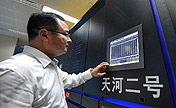

Extensive application
In November 2011, a cooperation agreement was signed by the Guangdong provincial government, Guangzhou municipal government, the National University of Defense Technology and Sun Yat-sen University to establish a Guangzhou supercomputing center by the end of 2015. The center aims to become China's fifth national supercomputing center after Tianjin, Shenzhen, Changsha and Jinan.
The $407.5 million project features Tianhe-2, which consists of 170 computer cabinets. The leading supercomputer, covering an area of 720 square meters, also boasts memory of 1.4 petabytes and storage capacity of 12.4 petabytes. Tianhe-2 will reportedly be transferred to Guangzhou and put into operation in October.
Wang Bingqiang is among the many scientific researchers in Guangdong province with high expectations of Tianhe-2.
As head of the high-performance computing team of BGI, a leading genome research institution based in Shenzhen, Wang said that the company's scientific research and commercial projects rely on supercomputers like Tianhe-2.
"Genetic research produces tremendous amounts of data that need to be stored and processed by supercomputers," he said. "The better utilization of the supercomputer, the more time and resources will be saved for our benefits."
BGI launched the Million Human Genomes Project in November 2011 to decode the genomes of more than 1 million people.
This project aims to establish a research baseline and reference standard for specific populations, as well as to connect the phenotypes of diseases and traits with genetic variations to understand disease mechanisms.
It will guide innovative clinical diagnosis and treatment, and ultimately advance personalized healthcare and improve human health, said Fang Lin, deputy director of BGI Research. He added that the current guide system will no longer satisfy the enormous needs of calculation and data processing of this project.
"Suppose we are scanning for a high resolution genetic variation landscape over more than 500 human individuals. It would take a single computer more than four years to finish the work," Wang said. "With the guide system, it requires about five hours, yet with Tianhe-2 the same amount of calculation needs only 10 minutes."
Not only companies and research institutions will benefit from the forthcoming supercomputer — people will also enjoy the convenience brought by Tianhe-2's vast storage and high-speed calculations.
"For instance, an electronic medical records system can be established under Tianhe-2 so that a patient's previous diagnosis and treatments will be accessible by different medical institutions, avoiding repeated examinations as in the past," said Lu Zexin, technical director of the Guangzhou Supercomputing Center.
"More information sharing among different departments will also curb red tape and lift working efficiency," he said.
Genetic engineering, biomedicine and animation industries have long prospered in Guangdong province.
Li, deputy chief designer, said that scientists have considered demands from these clients during feasibility studies of Tianhe-2 to ensure it provides better service.
So far, more than 600 users have registered. Concerns over Internet security have arisen in the wake of the recent revelations of US Internet monitoring by its PRISM program.
Lu said that Tianhe-2 adopts the Kylin operating system, a quality research product with high security developed by the National University of Defense Technology. It provides strict data isolation to guarantee security according to the needs of clients.
 |  |
 People welcome Chinese missile destroyer "Harbin"
People welcome Chinese missile destroyer "Harbin" CPAPF, Russia's Domestic Security Force joint training
CPAPF, Russia's Domestic Security Force joint training World Naked Bike Ride kicks off in Vancouver
World Naked Bike Ride kicks off in Vancouver Los Angeles' Chinatown sets up statue of Bruce Lee
Los Angeles' Chinatown sets up statue of Bruce Lee Photos:
Photos:  Triplet red pandas enjoy their life at Panda World
Triplet red pandas enjoy their life at Panda World Calling for new type of industry
Calling for new type of industry Double life: Editor with a rock heart
Double life: Editor with a rock heart Memorize the old Beijing with painting brush
Memorize the old Beijing with painting brush Giant panda spotted in the wild in NW China
Giant panda spotted in the wild in NW China Bidding on change
Bidding on change 'The Grandmaste' as opening film of Chinese Film Festival
'The Grandmaste' as opening film of Chinese Film Festival  Gold products:
Gold products:  Daring new collections hit fashion shops
Daring new collections hit fashion shops Tianhe-2 ranked as the world's fastest computer
Tianhe-2 ranked as the world's fastest computer